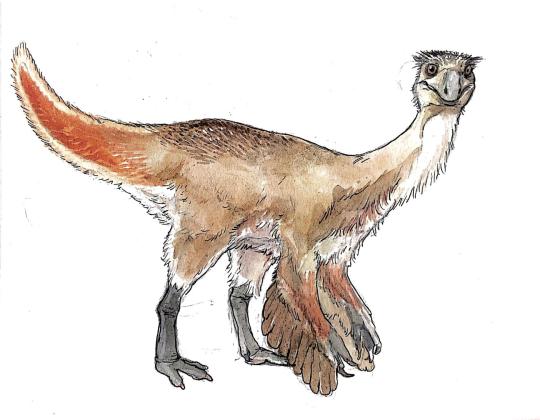
By Scott Reid
Etymology: Lightening Reptile from Nqweba
First Described By: de Klerk et al. 2000
Classification: Dinosauromorpha, Dinosauriformes, Dracohors, Dinosauria, Saurischia, Eusaurischia, Theropoda, Neotheropoda, Averostra, Tetanurae, Orionides, Avetheropoda, Coelurosauria, Tyrannoraptora, Maniraptoromorpha, Maniraptoriformes, Ornithomimosauria
Status: Extinct
Time and Place: About 140 million years ago, in the Berriasian of the Early Cretaceous


Nqwebasaurus is from the Upper member of the Kirkwood Formation of Eastern Cape, South Africa

Physical Description: Nqwebasaurus is one of the earliest known Ornithomimosaurs, that group of dinosaurs that would evolve to look vaguely like living Ostriches with longer tails – except those that looked like demon ducks, that is. Nqwebasaurus, thus, resembles what you’d expect the earliest member of this group to be – with some traits of later forms, but still overall looking like your generic small and fluffy theropod. It would probably have been only about 30 centimeters (1 foot) high at the hip, and only 0.9 meters long, though the original specimen was probably a juvenile and thus it was probably able to get larger. It had long arms, sporting three long fingers each, and at least one of them was somewhat opposable – and two of the claws are curved, while the third is not, a unique feature for most theropods but one seen in other Ornithomimosaurs. It had reduced teeth as well and gastroliths, showing the evolution of the Ornithomimosaur group towards supporting distinctive beaks. Nqwebasaurus would have also sported feathers, both fluffy ones for keeping warm and longer ones on the arms that would have resembled wings, allowing for Nqwebasaurus to sue them for display. Unlike later members of the group, it had a shorter, but not short, neck; and was squatter in general.

By Ripley Cook
Diet: Nqwebasaurus would have primarily fed on plants, probably being a low-level browser, not going into higher vegetation for food.
Behavior: Nqwebasaurus would have been a fairly skittish animal, being small in size – though it wasn’t as developed for cursoriality as its later relatives, and would have been limited in its ability to run away. So, Nqwebasaurus would have had to stay fairly alert, able to get away at the slightest provocation. Its fluff would have kept it warm – important, given it small stature – and it probably would have stuck to the undergrowth in its extremely forested environment, searching around for plants. Whether or not it lived in social groups is uncertain, but it probably took care of its young – protecting the eggs in its nest with its wings. In addition, the wings and tail fan would have been useful in social display, so communication via feather movement as well as vocalization was probably present in Nqwebasaurus.

By José Carlos Cortés
Ecosystem: Nqwebasaurus lived in the Kirkwood Formation, an environment lacking in many dinosaurs but utterly flourishing in plant fossils. This was a low-lying river system, rich in mud and sand, and overgrown with plants leading to a fairly forested environment for Nqwebasaurus to run around in. There were mosses and ferns and conifers and cycads and cycadeoids – a weird sort of plant that only existed from the Permian to the Oligocene. This lush environment provided many hiding spots for Nqwebasaurus, which had little in the way of defense. Still, given that, most animals that Nqwebasaurus shared its environment with were other herbivores. There was the stegosaur Paranthodon, the sauropod Algoasaurus, the tuataran Opisthias, and plenty of other unnamed reptiles (especially sauropods). Unnamed Carnosaurs are known, which would probably have been the main predators of Nqwebasaurus, though they were not very common.
Other: Nqwebasaurus is one of the most basal members of the Ornithomimosaurs, showcasing how the group began their evolution at the start of the Cretaceous. It is also nicknamed “Kirky”, after the formation it was found in.
~ By Meig Dickson
Sources under the Cut
